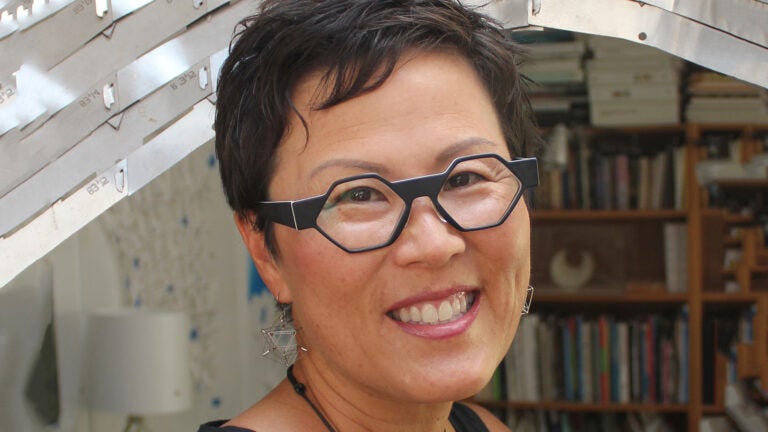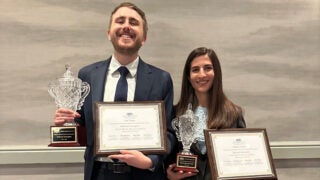
Award-winning design from USC architecture professor saves energy while using none
Though Doris Sung has won awards before, she hopes this particular one — the Cooper Hewitt 2021 National Design Award for climate action — will inspire the next generation of architects at USC.
Doris Sung is no stranger to recognition.
The founder of DOSU Studio Architecture and co-founder of TBM Designs has won numerous awards in both architecture and the arts. Her TEDx Talk has been viewed over 1.2 million times. She’s received fellowships from Google’s R+D for the Built Environment, United States Artists and the Rockefeller Foundation at Bellagio.
Still, she admits that winning the Cooper Hewitt 2021 National Design Award for climate action hasn’t quite set in yet.
“[This award] goes beyond the limits of what we as architects can do,” said Sung, director of undergraduate programs and associate professor at the USC School of Architecture. “It’s an organization that is in tune with not only the arts and a high level of design but a strong interest in equity and newer ideas about technology and materials.”
Started in 2000, the National Design Awards launched as an official project of the White House Millennium Council. The goal was to increase awareness and understanding of how design improves everyday life. The Cooper Hewitt, Smithsonian Design Museum is one of 19 museums that fall under the wing of the Smithsonian Institution.
Sung won for her InVert Self-Shading Window, a project she has been developing since 2015.
The window shades are made of a material called thermobimetal, a sheet metal composed of two different alloys that respond to heat. When the sun’s rays warm these pieces up, they will flip over and sit in a configuration that shades the building’s interior. Sung’s design places these pieces inside the cavity of a standard double-glazed window to provide a hands-free automatic shade to the building. After six years of development of what seems like something out of a sci-fi novel, the self-shading window is now a low-cost, commercially available way to combat climate change.
It’s a way to reduce greenhouse gases by using zero energy to save energy.
Doris Sung
“Doris is just so dedicated to the craft of architecture and really has a strong belief in the ability to utilize the skills of the architect to affect change in a very positive way,” said Milton S. F. Curry, dean of the USC School of Architecture. “I think that’s where maybe the public under appreciates the role of architects as both having the ability to practice architecture but also to formulate research questions that are novel and innovative and to act on those.”
Windows like these can reduce air conditioning usage by 25% while using zero energy. Around 40% of all energy used is in buildings — more than transportation or other industries — and 12% of that energy is spent on cooling interiors.
“It’s a way to reduce greenhouse gases by using zero energy to save energy,” Sung said. “If we can reduce that solar heat in the building, then basically we reduce the use of energy for air conditioning. If we can find ways to reduce even the smallest amount of air conditioning, it really makes a difference.”
Doris Sung’s climate action design focuses on affordability, wellness
An example of the shades is currently on display on the campus of California State University, Long Beach. The sm[ART]box, presented by the Carolyn Campagna Kleefeld Contemporary Art Museum, is a 20-foot steel shipping container with the InVert Self-Shading Window System installed that measures temperature and energy used.
The window is designed for large commercial buildings, as they would consume more energy to cool a larger space, but Sung said the same tech could be applied to residential areas as well. In fact, one of the key issues Sung took into consideration when starting this project was affordability.

“I don’t want to make these products that are just going to be used on expensive, fancy buildings, but as a product that can be used for everybody anywhere,” she said.
Another often-overlooked factor that Sung wanted to focus on was human wellness. One common and inexpensive method to cool buildings is through low-e coating on windows. Low-e coating is essentially sunglasses for windows. The coating minimizes the amount of ultraviolet and infrared light that can pass through the glass, though without compromising the amount of visible light that passes through. The issue with this, according to Sung, is that it reduces the amount of color spectrum people have, along with the amount of indirect daylight needed.
“Most people spend 90% of their lives indoors, right? If you start to think about 90% of your lives indoors, and you’re wearing sunglasses the entire time, what is it going to do to your home, human wellness and personal wellness?” she said.
“By using this new technology, we are able to eliminate or reduce the amount of coating that’s used for that. Anywhere that you can see through the shaded system, you’re looking through clearer glass, so therefore we’re able to bring in more of that color spectrum.”
For the second year in a row, the Cooper Hewitt 2021 National Design Awards will take place virtually, which Sung admits is the only bummer of this whole experience. Aside from creating a technology that could have a major impact on how businesses and even residences cut energy, as well as winning an award for it, Sung also hopes that this can inspire the next generation of architects at USC.
“I have huge hopes — which is probably why I enjoy being at a university — that either this technology or myself influences the next generation of designers, tinkerers, innovators and even the general public,” she said. “The more that we can get this out there, the better our world is going to be.”
Other Trojan award winners include:
Behnaz Farahi – Digital Design
Farahi earned a master’s degree in architecture from the USC School of Architecture, as well as her PhD in interdisciplinary media arts and practice from the USC School of Cinematic Arts. Her work is in the permanent collection of the Museum of Science and Industry, Chicago, and some of her clients include Adidas, Autodesk, Fuksas Studio, and 3DSystems / will-i-am. She is also currently an assistant professor of design at California State University, Long Beach.
Mia Lehrer – Landscape Architecture (Studio-MLA)
Lehrer, who has been a visiting faculty member at the USC School of Architecture, is the founder and president of Studio-MLA. With offices in L.A. and San Francisco, their projects include the Silver Lake Reservoir Path and Meadow, the Annenberg Community Beach House, the Banc of California Stadium and the Hollywood Park District.



